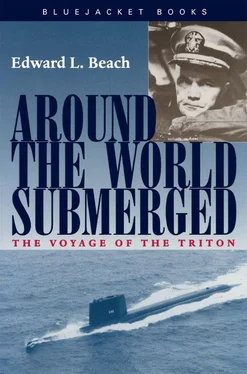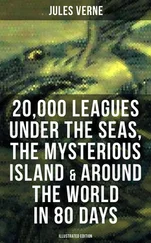0531 Periscope sextant is back in commission as the result of some rather inspired work by L. L. Garlock, FTC (SS) and W. E. Constantine, FT1 (SS).
Our submerged navigation was accomplished by several methods. One consisted of regular observation of the SINS mechanism, a system so new, however, that it was in effect an experimental model, full of bugs and therefore not dependable. Celestial observations through our special periscope proved to be far more accurate; and to Will’s satisfaction, dead-reckoning also surpassed the SINS. Since the celestial observations were by far the most accurate of the three methods, loss of the periscope equipment would have been serious, despite the stand-by system which, thanks to George Sawyer—who had put long hours into having it ready in case of need—we could have placed in service.
From the Log:
Midnight, 21 March A double babygram: an 8 pound 7 ounce girl [Frances Ann] for Leonard F. Lehman, Electrician’s Mate First Class; and 6 pound Kari Jeanne for Richard Brown, also Electrician’s Mate First Class. Birth dates respectively 15th and 18th of March. Mother’s and Father’s copies of babygrams are duly delivered. Fathers are honor-bound to bring the one with the cupids home to their wives.
Wednesday, 23 March 1960 0834 Crossed International Date Line from west longitude to east longitude at latitude 10° –36’ North. As this significant milestone was achieved, a message arrived from King Neptune informing us that because of our highly satisfactory conduct on 24 February, when we first crossed the equator, all hands were automatically, without further examination, taken into The Royal Order of Golden Dragons and so recorded in his log. There will, however, be a severe price.
Thursday, 24 March, is dropped from our calendar. This day, a full day from the lives of all hands, has been exacted from us in tribute for crossing the date line [technically speaking we advanced all clocks twenty-four hours]. Additional penance consists of working the ship for 24 full 25-hour days before we will be home again, although it should be noted that a number of these 25-hour days have already been worked off enroute to this area.
Still from the Log:
1733 The gravity meter indicated a rise in the ocean floor. There is no indication from sonar for 5 minutes, until 1738, when sonar detects a ledge from dead ahead around to port to a bearing of south.
1834 Gravity meter and sonar together show a dropping away in the ocean floor.
1933 First trial on our hand-made fathometer transducer: Unsuccessful.
The new fathometer transducer, the product of much inspired work by the Electronics Technicians gang under “Whitey” Rubb, had at last been completed, and had passed a successful test. In the Electronics Technicians’ workshop, a sonar signal set into the transducer was clearly heard outside it, even though the frequency response was theoretically in the inaudible range. The thing was worked in reverse also and was proven sensitive to the reception of noise beamed at it by radio or tape recorder at an approximately correct frequency. The problem now was to find some means of getting this sound into the water and catching it on the return.
Steel is a good conductor of sound. Our theory was that if we could send out a sufficiently strong signal, it might pass through the steel of our pressure hull and carry to the ocean floor, there to be reflected, hopefully, in sufficient strength to be detected either on the transducer itself or on one of our external hydrophones.
Another of our problems was that the pressure hull was the inner of Triton’s two hulls. When Jones had gone to work with the sledge hammer, we hoped that the water between the two hulls would carry the signal. But this experiment had been completely unsuccessful; in order to get the maximum possible chance of success with our handmade fathometer transducer, we had to do better.
There was, fortunately, a way to reach the outer skin of the ship itself, through the forward trim tank. Located in the space between the pressure hull and the outer hull, the tank had been built to withstand full test pressure and to meet the highest specifications of shock resistance. It also was accessible through a manhole cover at the bottom of the torpedo storeroom.
Tom Thamm adjusted the trim of the ship so that all water normally carried in the forward trim tank could be pumped out of it and into the midships auxiliary tanks. (Balance fore and aft was maintained by pumping an equal weight of water to auxiliaries from the after trim tank.) Then the tank was opened and tested for gas. After it had been pronounced clear, Lieutenant “Whitey” Rubb and Machinist Phil Kinnie descended into the heretofore sealed space, carrying our jury-rigged transducer with them.
Placing the new mechanism carefully against the skin of the ship, alongside the internal keel, they quickly made a connection to a cable from the fathometer transmitter nearby. After all was in readiness, we began the first test.
For a moment, we were greatly encouraged. We actually heard a sharp click, as the outgoing signal sped through our handmade transducer. But there was no returning echo. Various combinations were tried, including partially reflooding the forward trim tank so as to submerge the transducer and thus increase its ability to transmit through the bottom of the trim tank and to the water outside. But in the end, we were completely disappointed. The effort was unsuccessful.
“Whitey” was dejected. “I’m satisfied this isn’t going to work, Captain,” he said. “But I’d like to keep trying.”
The only bright spot of the day was receipt of our fifth babygram. A boy, Donald, Jr., for Engineman First Class Donald R. Quick.
From the Log:
Sunday, 27 March 1960 1349 We will soon be passing through our nearest point of approach to the presumed location at which the first Triton (SS-201) was lost in action during World War II. As a matter of interest, this took place almost exactly seventeen years ago, and by a strange coincidence the first Triton departed on her last patrol from Brisbane, Australia, on the same day (16 February) as we, her namesake, departed from New London on this voyage. Triton I is presumed to have been lost as a result of depth charge attack by three Japanese destroyers on 15 March 1943, in a position almost exactly 800 miles due south of where we are now.
At that time I was engineer officer of Trigger, also lost in action later in the war, and LCDR R. S. Benson, USN, was skipper. On 15 March 1943, as it happened, we were on patrol in the same general vicinity as Triton I. Correlation between the known facts of Triton’ s loss and Trigger’ s report of the events of that date indicates that the two ships may have attacked the same convoy. Trigger believed she had sunk one ship and damaged a second, and Triton’ s results were unknown. We were depth charged, though not severely. But afterwards we heard distant depth charges for approximately an hour. Japanese records indicate that the depth charging heard by Trigger most probably accounted for the loss of the old Triton. Their report of the action contains the notation that a large amount of oil came to the surface in the center of which floating objects were found bearing the label “Made in USA.”
It was Triton’s sixth patrol, but the first for her new commander, LCDR George K. McKenzie, Jr. Besides her skipper, she had on board an unusual array of talent in LCDR John Eichmann, Executive Officer, and LCDR Jack R. Crutchfield, who was, I believe, Engineer. Eichmann had been with the Triton since she was commissioned in 1940. His name is engraved upon Triton’ s old commissioning plaque, presented to us last November 10 by Mrs. Lent, widow of the late Rear Admiral W. A. Lent, Triton I’s first skipper. The plaque is now mounted in the passageway outside our wardroom.
Читать дальше












